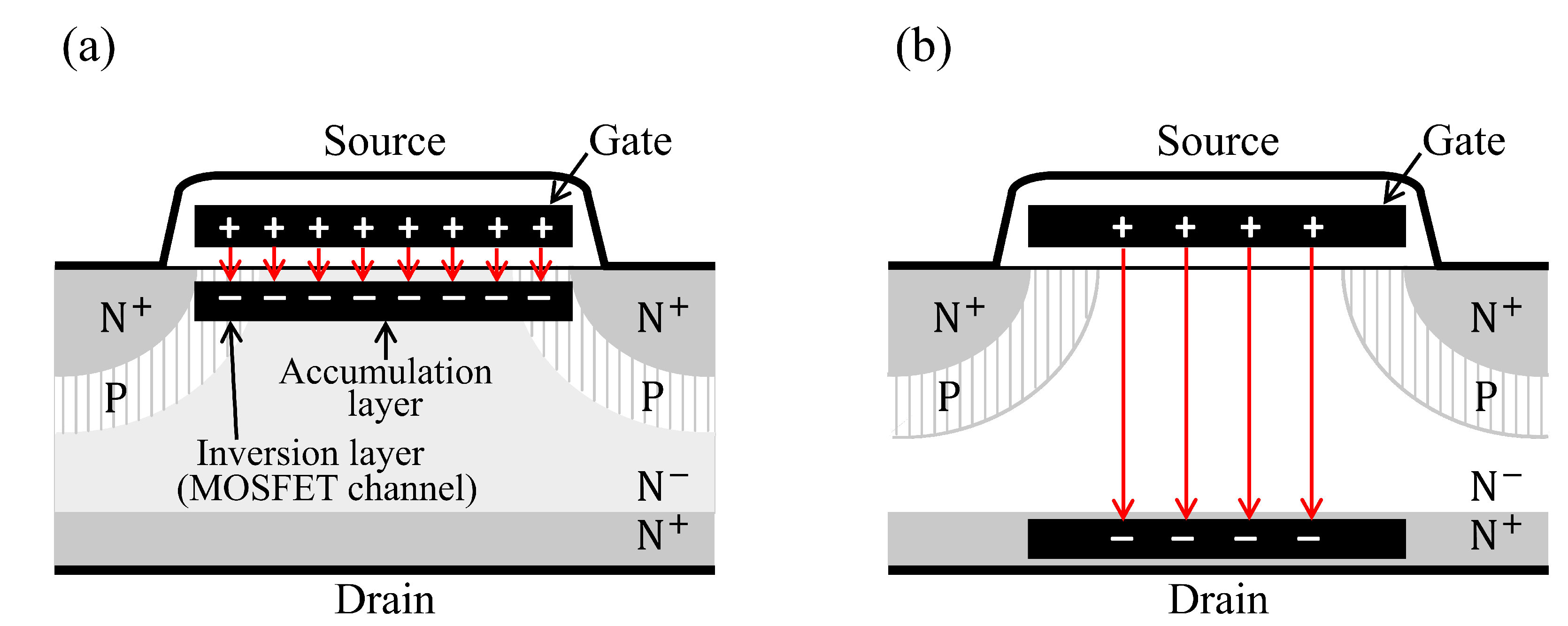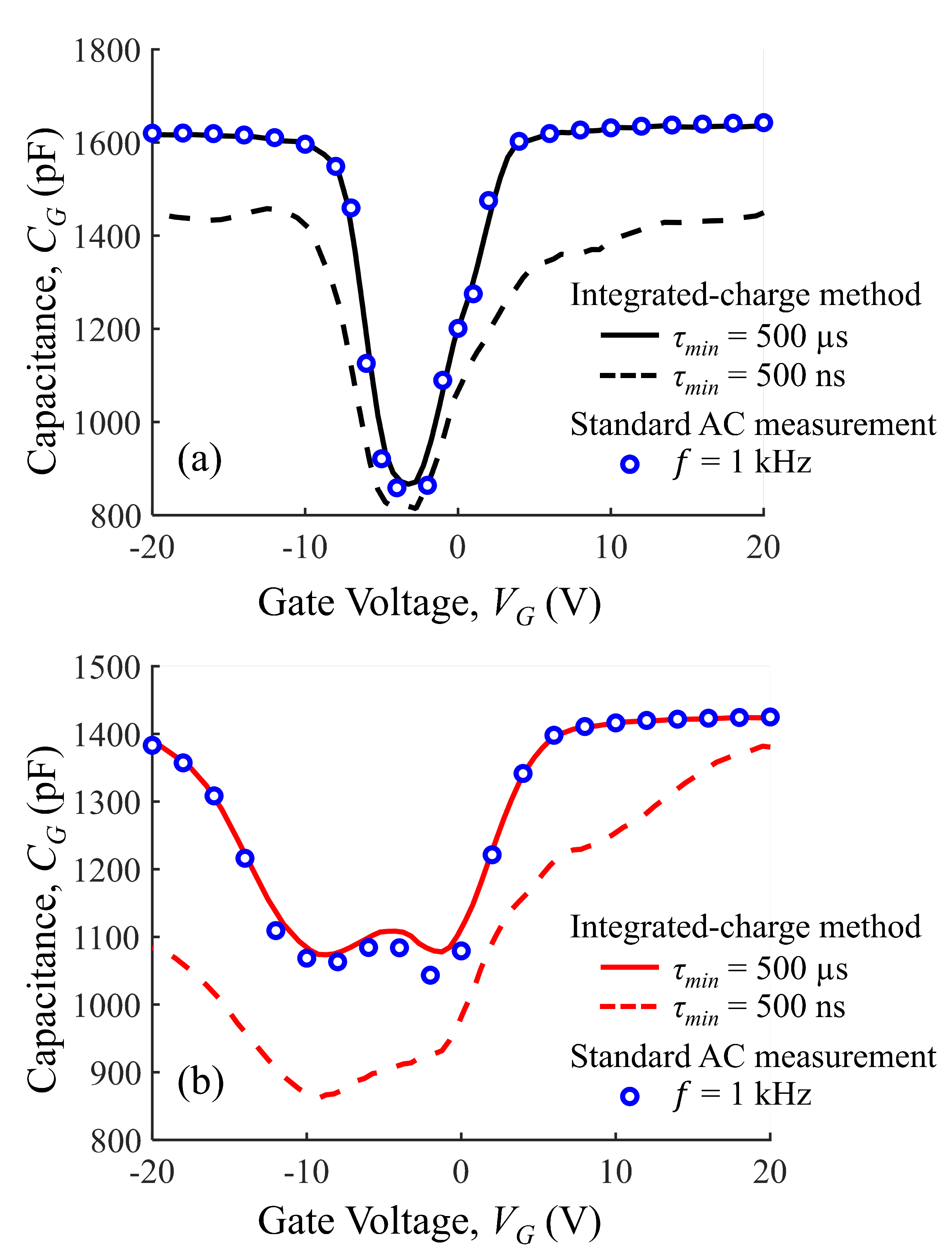A Figure of Merit for Selection of the Best Family of SiC Power MOSFETs
Abstract
:1. Introduction
2. Theory
2.1. Dependence of on-Resistance on the Density of near Interface Traps
2.2. The Figure of Merit for Selection/Comparison of SiC MOSFET Families
3. Experimental Demonstration
3.1. Measurement of Gate Capacitance and On-Resistance
3.2. Measurement of the Density of Near-Interface Traps
4. Application to Commercial Devices
5. Conclusions
Author Contributions
Funding
Data Availability Statement
Conflicts of Interest
References
- Hazra, S.; De, A.; Cheng, L.; Palmour, J.; Schupbach, M.; Hull, B.A.; Allen, S.; Bhattacharya, S. High Switching Performance of 1700-V, 50 A SiC Power MOSFET Over Si IGBT/BiMOSFET for Advanced Power Conversion Applications. IEEE Trans. Power Electron. 2016, 31, 4742–4754. [Google Scholar]
- Dimitrijev, S.; Han, J.; Moghadam, H.A.; Aminbeidokhti, A. Power-switching Applications beyond Silicon: Status and Future Prospects of SiC and GaN Devices. MRS Bull. 2015, 40, 399–405. [Google Scholar] [CrossRef]
- Li, S.; Lu, S.; Mi, C.C. Revolution of Electric Vehicle Charging Technologies Accelerated by Wide Bandgap Devices. Proc. IEEE 2021, 109, 985–1003. [Google Scholar] [CrossRef]
- Kimoto, T.; Watanabe, H. Defect Engineering in SiC Technology for High-Voltage Power Devices. Appl. Phys. Exp. 2020, 13, 399–405. [Google Scholar] [CrossRef]
- Fiorenza, P.; Giannazzo, F.; Roccaforte, F. Characterization of SiO2/4H-SiC Interfaces in 4H-SiC MOSFETs: A Review. Energies 2019, 12, 2310. [Google Scholar] [CrossRef] [Green Version]
- Pande, P.; Haasmann, D.; Han, J.; Moghadam, H.A.; Tanner, P.; Dimitrijev, S. Electrical Characterization of SiC MOS Capacitors: A Critical Review. Microelectron. Reliab. 2020, 112, 113790. [Google Scholar] [CrossRef]
- Chaturvedi, M.; Dimitrijev, S.; Haasmann, D.; Moghadam, H.A.; Pande, P.; Jadli, U. Quantified Density of Performance-Degrading Near-Interface Traps in SiC MOSFETs. Sci. Rep. 2022, 12, 4076. [Google Scholar] [CrossRef] [PubMed]
- Lelis, A.J.; Green, R.; Habersat, D.B. SiC MOSFET Threshold-Stability Issues. Mater. Sci. Semicond. Process. 2018, 78, 32–37. [Google Scholar] [CrossRef]
- Jiang, H.; Zhong, X.; Qiu, G.; Tang, L.; Qi, X.; Ran, L. Dynamic Gate Stress Induced Threshold Voltage Drift of Silicon Carbide MOSFET. IEEE Electron Device Lett. 2020, 41, 1284–1287. [Google Scholar] [CrossRef]
- Urresti, J.; Arith, F.; Olsen, S.; Wright, N.; O’Neill, A. Design and Analysis of High Mobility Enhancement-Mode 4H-SiC MOSFETs using a Thin-SiO2/Al2O3 Gate-Stack. IEEE Trans. Electron Devices 2019, 66, 1710–1716. [Google Scholar] [CrossRef] [Green Version]
- Tachiki, K.; Kaneko, M.; Kimoto, T. Mobility Improvement of 4H-SiC (0001) MOSFETs by a Three-Step Process of H2 Etching, SiO2 Deposition, and Interface Nitridation. Appl. Phys. Exp. 2021, 14, 031001. [Google Scholar] [CrossRef]
- Moghadam, H.A.; Dimitrijev, S.; Han, J.; Haasmann, D. Active Defects in MOS Devices on 4H-SiC: A Critical Review. Microelectron. Rel. 2016, 60, 1–9. [Google Scholar] [CrossRef]
- Pande, P.; Dimitrijev, S.; Haasmann, D.; Moghadam, H.A.; Chaturvedi, M.; Jadli, U. Impact of Nitridation on the Active Near-Interface Traps in Gate Oxides on 4H-SiC. Solid-State. Electron. 2020, 171, 107874. [Google Scholar] [CrossRef]
- Chaturvedi, M.; Dimitrijev, S.; Moghadam, H.A.; Haasmann, D.; Pande, P.; Jadli, U. Fast Near-Interface Traps in 4H-SiC MOS Capacitors Measured by an Integrated-Charge Method. IEEE Access 2021, 9, 109745–109753. [Google Scholar] [CrossRef]
- Friedrichs, P. High-Performance CoolSiC™ MOSFET Technology with Silicon-Like Reliability. Infineon Technologies. Available online: www.infineon.com (accessed on 3 January 2022).
- Baliga, B.J. Power MOSFETs. In Fundamentals of Power Semiconductor Devices, 2nd ed.; Springer: Raleigh, NA, USA, 2019; pp. 413–449. [Google Scholar]
- Dimitrijev, S. MOSFET. In Principles of Semiconductor Devices, 2nd ed.; Oxford University Press: New York, NY, USA, 2012; pp. 470–472. [Google Scholar]
- Pezzimenti, F.; Bencherif, H.; De Martino, G.; Dehimi, L.; Carotenuto, R.; Merenda, M.; Della Corte, F.G. Study and Assessment of Defect and Trap Effects on the Current Capabilities of a 4H-SiC-Based Power MOSFET. Electronics 2021, 10, 735. [Google Scholar] [CrossRef]
- Jadli, U.; Mohd-Yasin, F.; Moghadam, H.A.; Pande, P.; Chaturvedi, M.; Dimitrijev, S. A Method for Selection of Power MOSFETs to Minimize Power Dissipation. Electronics 2021, 10, 2150. [Google Scholar] [CrossRef]
- Pande, P.; Dimitrijev, S.; Haasmann, D.; Moghadam, H.A.; Tanner, P.; Han, J. Direct Measurement of Active Near-Interface Traps in the Strong-Accumulation Region of 4H-SiC MOS Capacitors. IEEE J. Electron Devices Soc. 2018, 6, 468–474. [Google Scholar] [CrossRef]
- Agarwal, A.; Han, K.; Baliga, B.J. 600 V 4H-SiC MOSFETs Fabricated in Commercial Foundry with Reduced Gate Oxide Thickness of 27 nm to Achieve IGBT-Compatible Gate Drive of 15 V. IEEE Electron Device Lett. 2019, 40, 1792–1795. [Google Scholar] [CrossRef]



| MOSFET ID | Manufacturer | Gate Structure | On-Resistance (m) | Gate Capacitance (pF) |
|---|---|---|---|---|
| A-T | A | Trench | 90 | 977 |
| 350 | 280 | |||
| B-P | B | Planar | 281 | 530 |
| C2-P | C | Planar | 360 | 583 |
| C3-P | C | Planar | 282 | 592 |
| D-T | D | Trench | 105 | 1424 |
| D-P | D | Planar | 280 | 1635 |
| E-P | E | Planar | 192 | 1295 |
Publisher’s Note: MDPI stays neutral with regard to jurisdictional claims in published maps and institutional affiliations. |
© 2022 by the authors. Licensee MDPI, Basel, Switzerland. This article is an open access article distributed under the terms and conditions of the Creative Commons Attribution (CC BY) license (https://creativecommons.org/licenses/by/4.0/).
Share and Cite
Chaturvedi, M.; Dimitrijev, S.; Haasmann, D.; Moghadam, H.A.; Pande, P.; Jadli, U. A Figure of Merit for Selection of the Best Family of SiC Power MOSFETs. Electronics 2022, 11, 1433. https://doi.org/10.3390/electronics11091433
Chaturvedi M, Dimitrijev S, Haasmann D, Moghadam HA, Pande P, Jadli U. A Figure of Merit for Selection of the Best Family of SiC Power MOSFETs. Electronics. 2022; 11(9):1433. https://doi.org/10.3390/electronics11091433
Chicago/Turabian StyleChaturvedi, Mayank, Sima Dimitrijev, Daniel Haasmann, Hamid Amini Moghadam, Peyush Pande, and Utkarsh Jadli. 2022. "A Figure of Merit for Selection of the Best Family of SiC Power MOSFETs" Electronics 11, no. 9: 1433. https://doi.org/10.3390/electronics11091433
APA StyleChaturvedi, M., Dimitrijev, S., Haasmann, D., Moghadam, H. A., Pande, P., & Jadli, U. (2022). A Figure of Merit for Selection of the Best Family of SiC Power MOSFETs. Electronics, 11(9), 1433. https://doi.org/10.3390/electronics11091433









